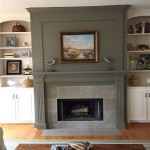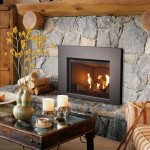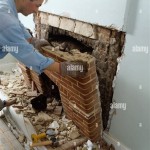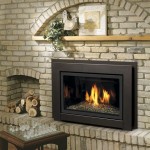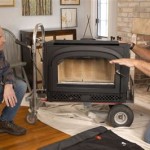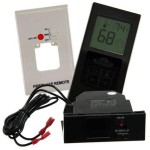Cleaning a Brick Fireplace Hearth: A Comprehensive Guide
A brick fireplace hearth provides a classic and enduring focal point in many homes. However, its porous surface readily absorbs soot, ash, and other residues from burning wood, leading to discoloration and a less-than-desirable appearance. Routine cleaning and appropriate techniques are essential to maintaining the pristine condition of a brick fireplace hearth and prolonging its lifespan. This article provides a comprehensive guide on how to effectively clean a brick fireplace hearth, covering preparation, cleaning methods, and preventative maintenance.
Preparing to Clean the Brick Fireplace Hearth
Before commencing any cleaning procedure, it is crucial to adequately prepare the area. This preparation process minimizes the risk of damage to surrounding surfaces and optimizes the efficacy of the cleaning efforts. Essential steps include removing loose debris, protecting adjacent areas, and assembling the necessary cleaning materials.
The initial step involves the removal of any loose debris accumulated on the hearth. This includes ash, soot, stray pieces of wood, and any other visible particles. A broom and dustpan are typically sufficient for this task. A shop vacuum equipped with a brush attachment can also be used for a more thorough removal of fine particles. Exercise caution during this process to avoid stirring up dust and creating a mess in the surrounding room. Consider wearing a dust mask to prevent inhalation of airborne particles.
Protecting adjacent areas is paramount, especially if using chemical cleaning solutions. Spread drop cloths or old towels around the hearth to shield the surrounding flooring, rugs, and furniture from potential splashes or drips. Secure the edges of the drop cloths with painter's tape to prevent them from shifting during the cleaning process. If the fireplace opening is accessible, consider sealing it off with plastic sheeting or a heavy cloth to prevent cleaning solutions from entering the firebox.
The final step in preparing the cleaning process involves assembling the necessary cleaning materials. The specific materials required will vary depending on the chosen cleaning method and the severity of the staining. However, some common and essential items include:
- A stiff-bristled scrub brush (preferably with a long handle)
- A bucket or container for holding cleaning solutions
- Various cleaning solutions (e.g., dish soap, trisodium phosphate (TSP), vinegar, baking soda, commercial brick cleaner)
- Clean cloths or sponges
- A garden hose with a spray nozzle (optional, for rinsing)
- Rubber gloves
- Eye protection (goggles or safety glasses)
- A dust mask or respirator (especially when using TSP or other harsh chemicals)
Having all the necessary materials readily available will streamline the cleaning process and minimize interruptions.
Cleaning Methods for Brick Fireplace Hearths
Several methods can be employed to clean a brick fireplace hearth, each with its own advantages and disadvantages. The choice of method should be based on the type and severity of the staining, as well as personal preferences regarding the use of chemical cleaners. The methods range from simple solutions using household items to more potent commercial brick cleaners.
Mild Cleaning with Dish Soap and Water: This method is suitable for light cleaning and maintenance. Mix a few drops of dish soap with warm water in a bucket. Dip a scrub brush into the soapy water and scrub the brick hearth, focusing on stained areas. Rinse the hearth thoroughly with clean water using a cloth or sponge. For stubborn stains, allow the soapy water to sit on the stained area for a few minutes before scrubbing. Repeat the process as needed until the hearth is clean. This is generally a safe and effective method for routine maintenance and light stain removal.
Using Vinegar and Baking Soda: This method is an effective, natural alternative. A paste of baking soda and water can be applied to stained areas and allowed to sit for several hours before scrubbing and rinsing. Alternatively, a solution of equal parts white vinegar and water can be sprayed onto the brick and scrubbed. Vinegar is a mild acid that helps dissolve soot and grime. Baking soda acts as a gentle abrasive, aiding in the removal of stubborn stains. This method is suitable for moderate staining and is a good option for those seeking a chemical-free cleaning solution.
Cleaning with Trisodium Phosphate (TSP): TSP is a powerful cleaning agent that is effective for removing heavy soot deposits and stubborn stains. However, it should be used with caution, as it can be harmful if ingested or inhaled. Always wear rubber gloves, eye protection, and a dust mask or respirator when working with TSP. Mix TSP according to the manufacturer's instructions. Apply the solution to the brick hearth using a scrub brush and allow it to sit for a few minutes. Scrub the hearth thoroughly and rinse with clean water. TSP can etch or discolor certain surfaces, so it is crucial to test it in an inconspicuous area before applying it to the entire hearth. Proper ventilation is essential when using TSP due to its strong odor. This is generally reserved for heavily soiled hearths. The use of TSP followed by a thorough rinse is of utmost importance as it can leave a residue.
Employing Commercial Brick Cleaners: Several commercial brick cleaners are available that are specifically formulated for removing soot, grime, and other stains from brick surfaces. These cleaners typically contain a combination of detergents, solvents, and acids. Follow the manufacturer's instructions carefully when using commercial brick cleaners. Some cleaners may require dilution, while others may be used undiluted. Always test the cleaner in an inconspicuous area before applying it to the entire hearth to ensure that it does not damage or discolor the brick. Wear appropriate protective gear, including rubber gloves and eye protection. Commercial brick cleaners can be highly effective, but they should be used with caution and in well-ventilated areas. Many brick cleaners require neutralization with a specific product after use. It's important to review the manufacturer's instruction thoroughly prior to application.
Pressure Washing (Proceed with Caution): A pressure washer can be used to clean a brick fireplace hearth, but it should be used with extreme caution. The high pressure can damage the brick, especially if the mortar joints are weak or deteriorated. If using a pressure washer, use a low-pressure setting and a wide-angle nozzle. Keep the nozzle at a distance from the brick surface and avoid directing the spray at the mortar joints. Test the pressure washer in an inconspicuous area before cleaning the entire hearth. Pressure washing can be an effective method for removing heavy soot deposits, but it is essential to exercise caution to avoid damaging the brick. This cleaning method is generally not recommended.
After cleaning, allow the brick hearth to dry completely. This may take several hours or even overnight, depending on the humidity and ventilation.
Preventative Maintenance for Brick Fireplace Hearths
Preventative maintenance is key to keeping a brick fireplace hearth clean and minimizing the need for intensive cleaning in the future. Regular sweeping, prompt spot cleaning, and the application of a sealant can significantly reduce the buildup of soot and grime.
Regular sweeping is perhaps the simplest and most effective form of preventative maintenance. Sweep the hearth regularly, preferably after each use of the fireplace, to remove loose ash and soot. This prevents the buildup of these materials and makes future cleaning much easier. A broom and dustpan are sufficient for this task, or a shop vacuum with a brush attachment can be used for a more thorough cleaning.
Prompt spot cleaning is also crucial. If any spills or stains occur on the hearth, clean them up immediately. The longer a stain sits, the harder it will be to remove. Use a damp cloth or sponge to blot up the spill. For stubborn stains, use a mild cleaning solution, such as dish soap and water, as described above. By addressing stains promptly, one can prevent them from setting in and becoming more difficult to remove. This includes grease stains, from food preparation nearby.
Applying a sealant can provide a protective barrier against soot, grime, and other stains. Several brick sealants are available that can be applied to the hearth. These sealants typically create a water-repellent surface that makes it easier to clean up spills and prevent stains from penetrating the brick. Follow the manufacturer's instructions carefully when applying a sealant. Before applying a sealant to the entire hearth, test it in an inconspicuous area to ensure that it does not alter the appearance of the brick. Reapply the sealant as needed, according to the manufacturer's recommendations. Sealants won't eliminate the need for cleaning, but they will help to prevent stains from penetrating deep into the brick.
In addition to these preventative measures, consider using a fireplace screen to prevent sparks and embers from landing on the hearth. A screen can also help to contain ash and soot, reducing the amount of cleanup required. Ensure the fireplace is professionally inspected and cleaned regularly. A clean chimney and flue contribute to more efficient burning and less soot production, ultimately resulting in a cleaner hearth.
By following these cleaning methods and preventative maintenance tips, homeowners can maintain the beauty and functionality of their brick fireplace hearth for years to come. Regular cleaning and preventative measures will not only enhance the appearance of the hearth but also protect the brick surface from damage and prolong its lifespan.

How To Clean A Fireplace Diy Basics

How To Clean A Brick Fireplace With Scrubbing Bubbles 2024 Today S Homeowner

How To Clean Fireplace Bricks 9 Steps With S Wikihow

How To Clean Brick Fireplaces Mantels Hearths And More My Space

How To Clean Fireplace Bricks Simple Practical Beautiful

Mortar Wash Brick Fireplace Makeover Dimples And Tangles

How To Clean White Fireplace Brick A Comprehensive Guide Dreifuss Fireplaces

Best Way To Clean A Fireplace Stacy Risenmay

How To Clean A Brick Fireplace The Family Handyman

How To Clean White Fireplace Brick A Comprehensive Guide Dreifuss Fireplaces
Related Posts

